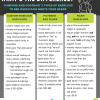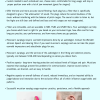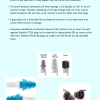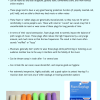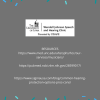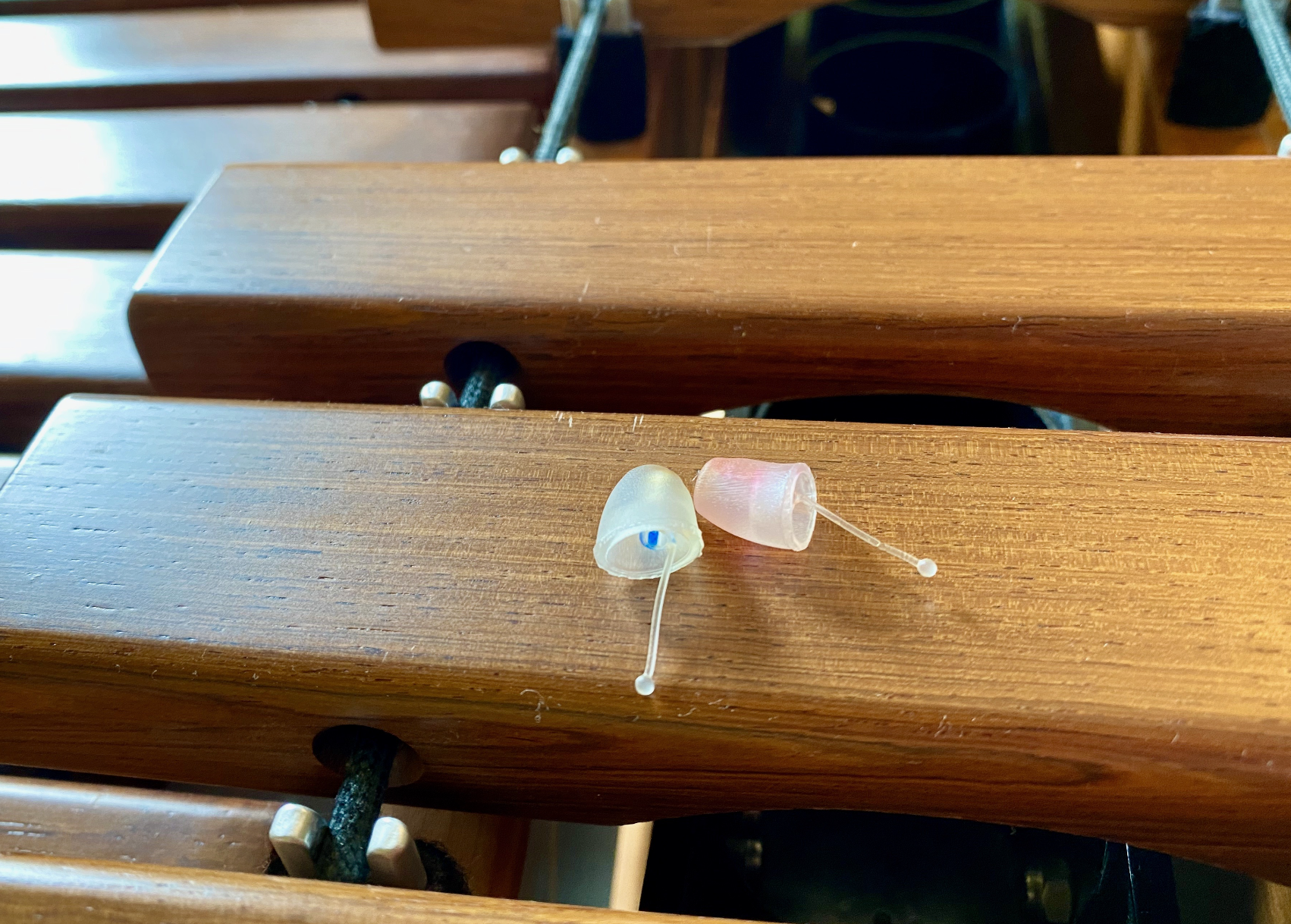See also: Articles on Music, Hearing Loss, and Hearing Devices 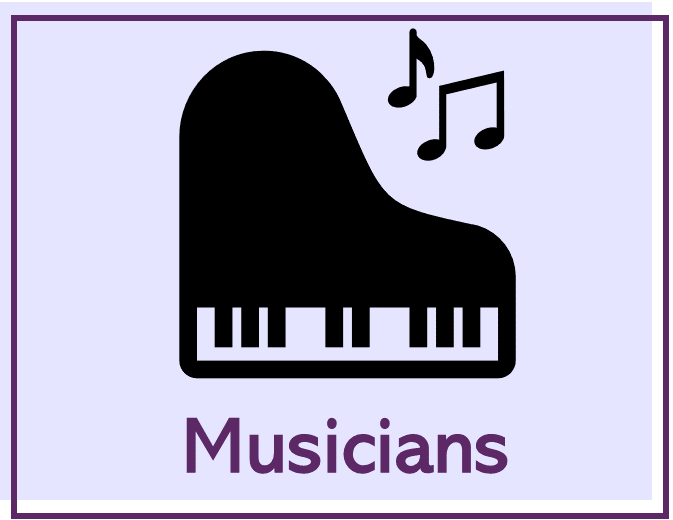
As you read this website, keep in mind the following:
-
People with hearing loss can differ in many ways.
-
Some information may be more similar to your situation.
-
Pick and choose the information most useful for you.
Music Making and Hearing Loss:
Information for Musicians on Preventing or Managing Hearing Loss
Musicians have unique needs regarding hearing loss and hearing conservation. Different types of musicians may find different approaches and strategies towards hearing health useful to them. This page will cover:
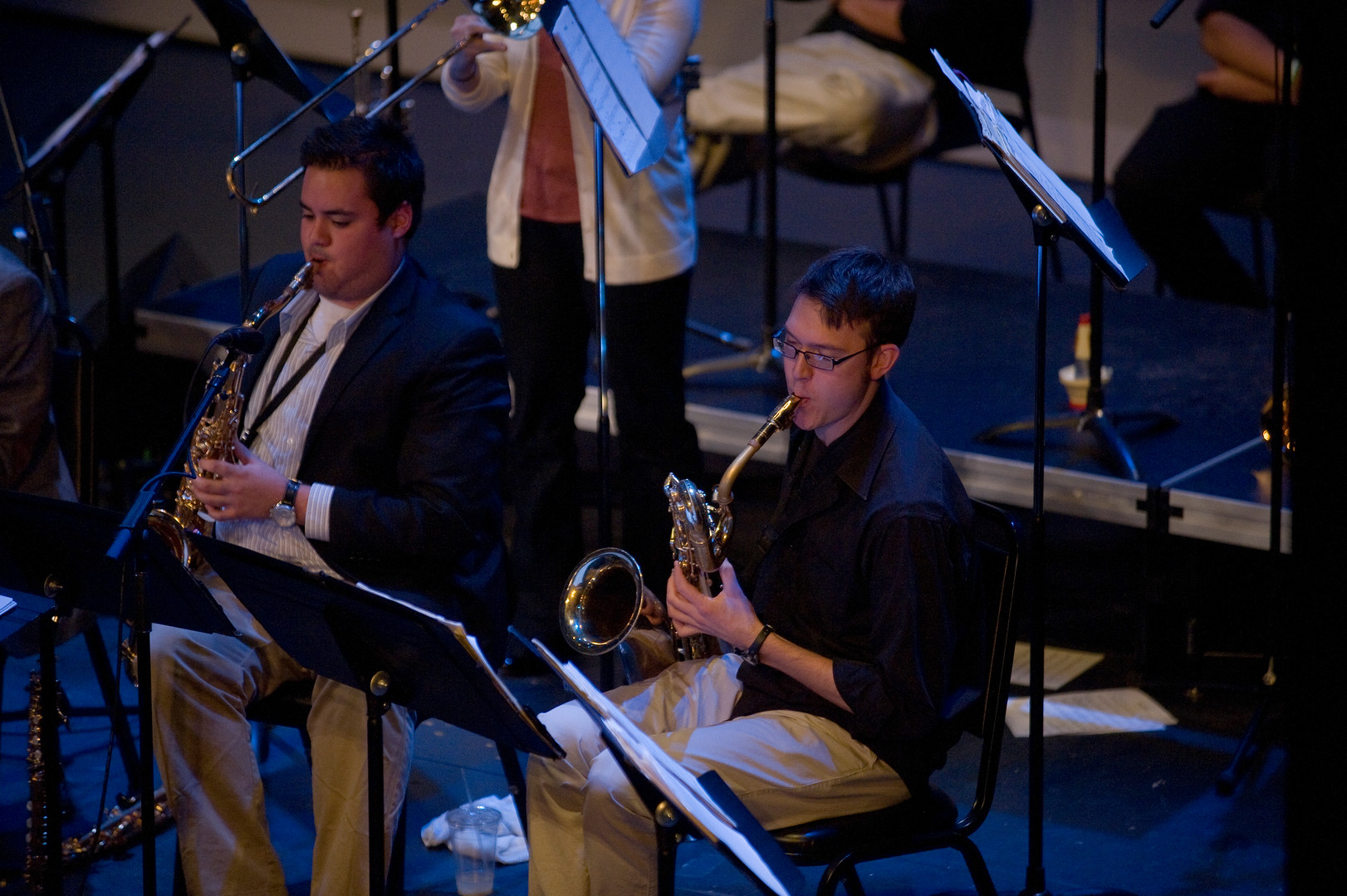
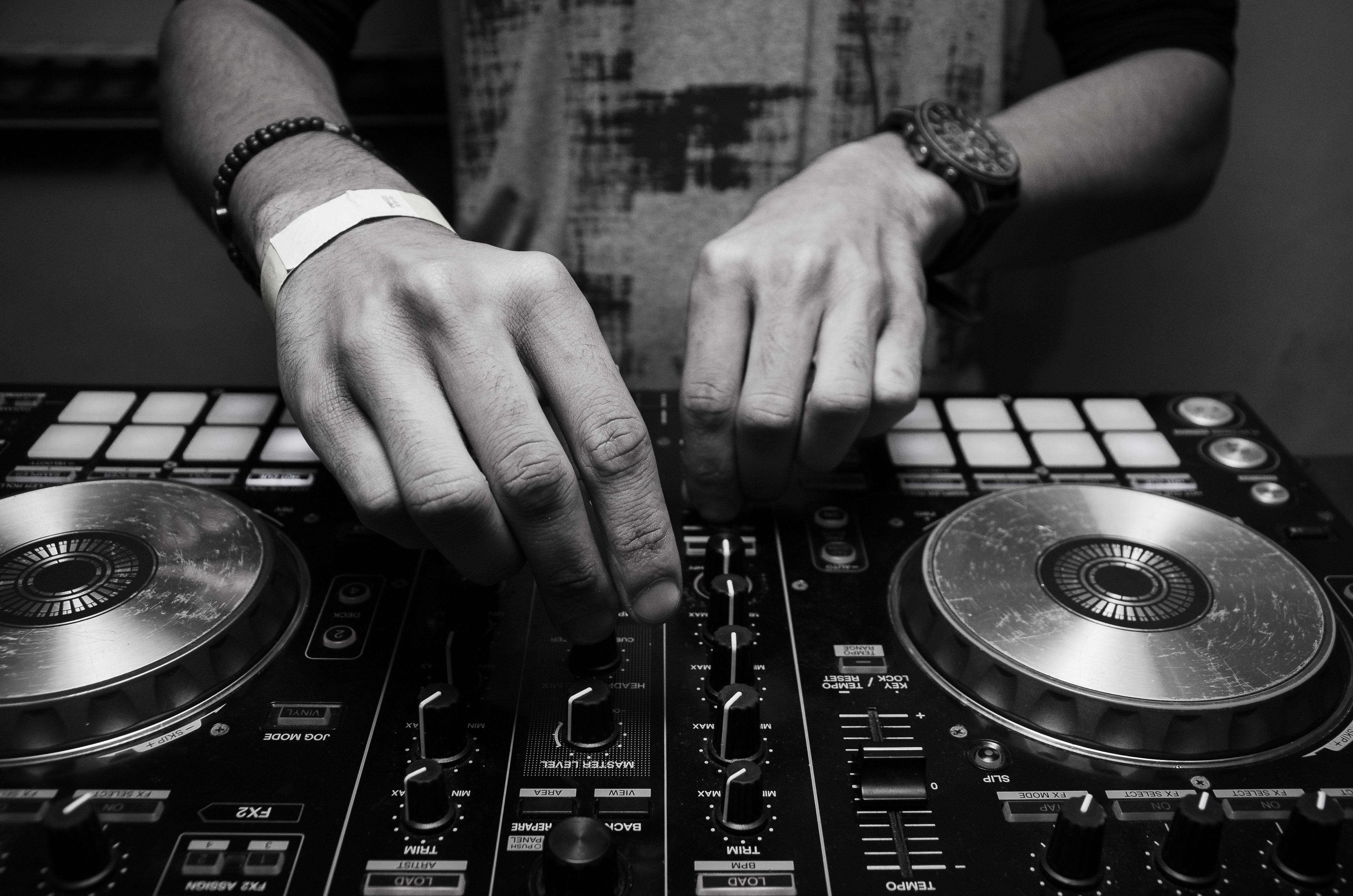
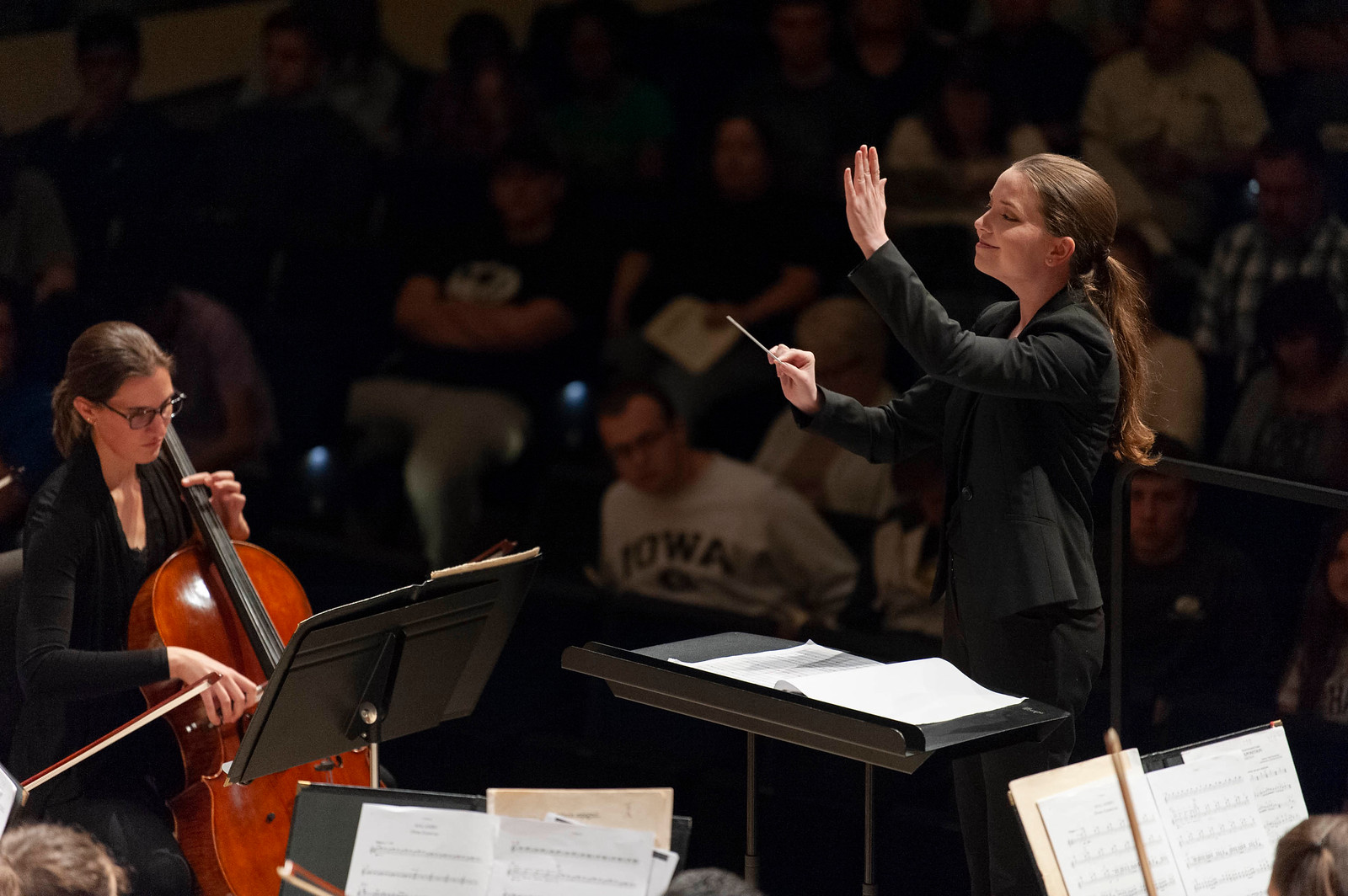
1, 2
[Note: For basic information about hearing loss, click here. For information about the UIHC hearing clinic, click here. For information on hearing aids, click here. For information on hearing loss prevention, click here.]
Why SHOULD musicians care about hearing loss?
-
Musicians’ livelihoods are based off of their ability to hear. Pitch discrimination, rhythmic timing, timbre detection, and loudness are all perceptions that may deteriorate with hearing loss. This may potentially cause job loss and decreased quality of life.
-
A majority of musicians have experienced a hearing loss (temporary or permanent) some time in their career (Chasin, 2014).
-
Younger musicians tend to experience tinnitus, while older musicians experience hyperacusis and hearing loss in both ears (Greasley et al., 2020).
What about student musicians' risk?


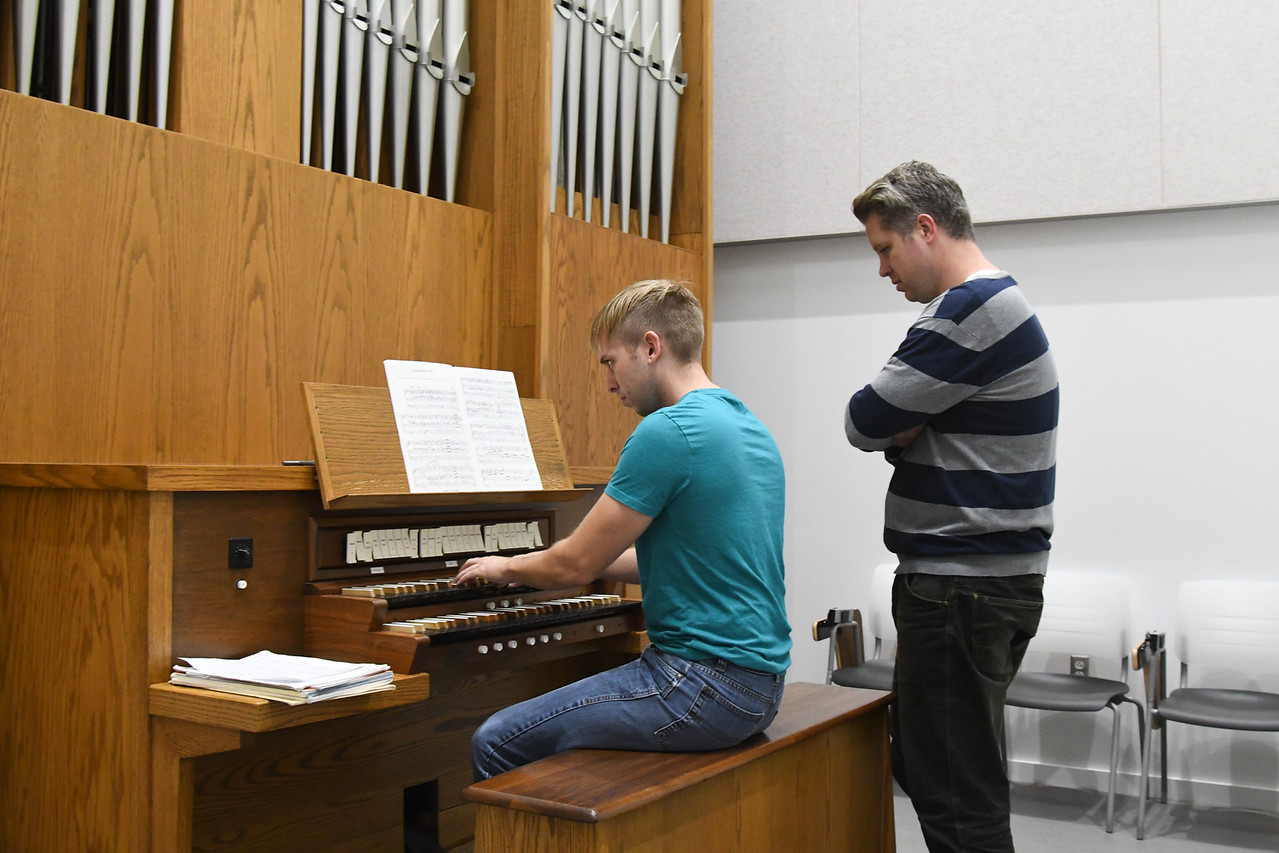
-
Student musicians may be at an increased risk for hearing loss: Some studies show that half of student musicians have premature hearing loss. This includes vocalists and instrumentalists (Phillips et al., 2008). Another study (Pawlaczyk-Luszczynska et al., 2017) found that more music students than non-music students experienced hearing impairments such as:
-
Difficulty hearing speech sounds clearly
-
Difficulty understanding conversations in a noisy environment
-
Temporary or constant tinnitus (ringing or buzzing in the ears)
-
Hyperacusis (decreased sound tolerance)
-
-
Student musicians may have increased listening exposure: More music students than non-music students tend to use personal listening devices and attend music clubs. This contributes to longer exposure to loud sounds, which can be particularly harmful (Pawlaczyk-Luszczynska et al., 2017).
-
Overexposure: 82% of teenagers say they listen to music every day for approximately two and a half hours (Rideout & Robb, 2019).
-
Levey et al. (2011) found that 58.2% of college students exceeded daily noise limits, and 51.9% exceeded weekly noise exposure limits.
-
Increased exposure to loud volume:
-
Pep bands and marching bands often play at sound levels exceeding the national recommendation. Some studies have reported exposure as much as 941-5,951% the daily noise recommendation (Hodges, 2009). This puts student musicians at an increased risk of early hearing loss
-
-
-
High volume + long duration = damage to hearing
-
The extent of damage is predicted by how LOUD and how LONG you are listening, not what device you're listening through.
-
-

-
Preferred volume is subjective and personal. One person's "too loud" is a safe listening level, while another person's "quiet" is not. You may also underestimate how loud music is. Did you know you can have the level at which you listen to your music measured? This is how you can learn if your preferred listening level is too loud or safe.
Do music teachers experience hearing loss?

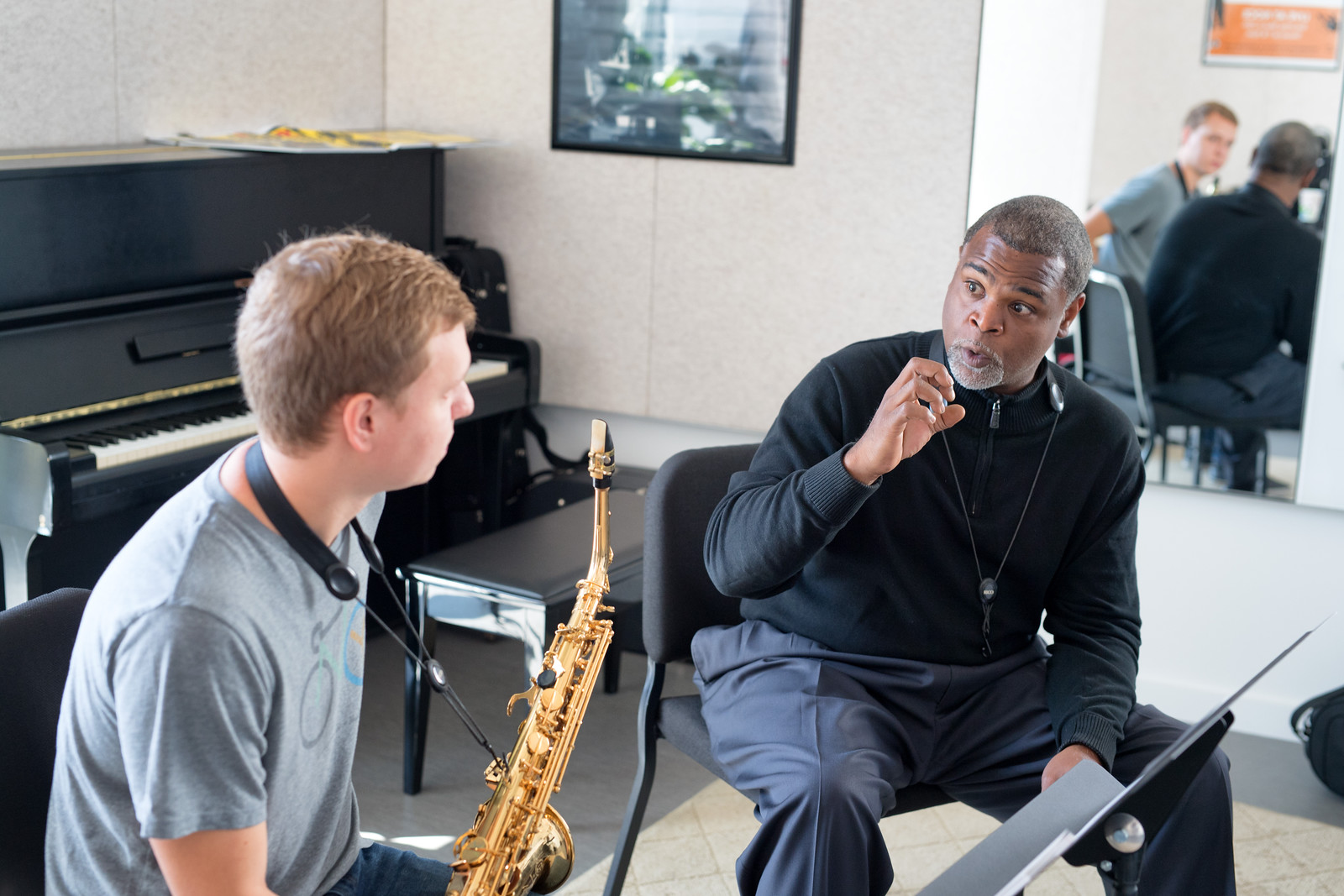
-
Yes, music teachers may be at an increased risk for hearing loss: Music teachers may be exposed to excessive noise levels as part of their regular work responsibilities. In one study, music teachers' noise dosage ranged from 2-727% the recommendation. All the brass teachers were at risk of hearing loss, and half of the percussion teachers, accompanists, and jazz conductors were also at risk of permanent hearing loss (Walter et al., 2008).
-
Increased exposure to loud volume: Some studies show that as many as 3 out of 4 music educators are commonly exposed to volume levels above the national daily recommendation (Behar, 2004).
-
Poor listening environment: Reverberant environments create a higher noise dosage than typical music practice rooms or non-echoey settings. This is especially problematic for average elementary and high school linoleum floor and walls, which may create excessive noise and possible hearing damage (Smith et al., 2019).
-
Do musicians exceed their maximum noise dosage often?
-
Musicians are exposed regularly to excessive noise: Many musicians may reach the nationally recommended daily noise dosage in a short amount of time.
-
One study reported that a collegiate trumpet player reached his daily noise allowance in just 38 minutes of practicing (Phillips & Mace, 2008).
-
In a study of 693 professional musicians, half were worried about noise exposure at work (Greasley et al., 2020).
-
Ensemble: Orchestral musicians were most worried about noise at work.
-
Instrument: Brass players were the most worried about noise at work, with string players next, and then percussionists.
-
Occupation: More than half of musicians believed their occupation was the main factor contributing to their hearing loss.
-
-
-
Musicians may be unaware of exceeding noise dosage: Because we don't think of music as noise, we may underestimate how loud it really is.
Which instruments and ensembles pose the greatest risk
for hearing loss?
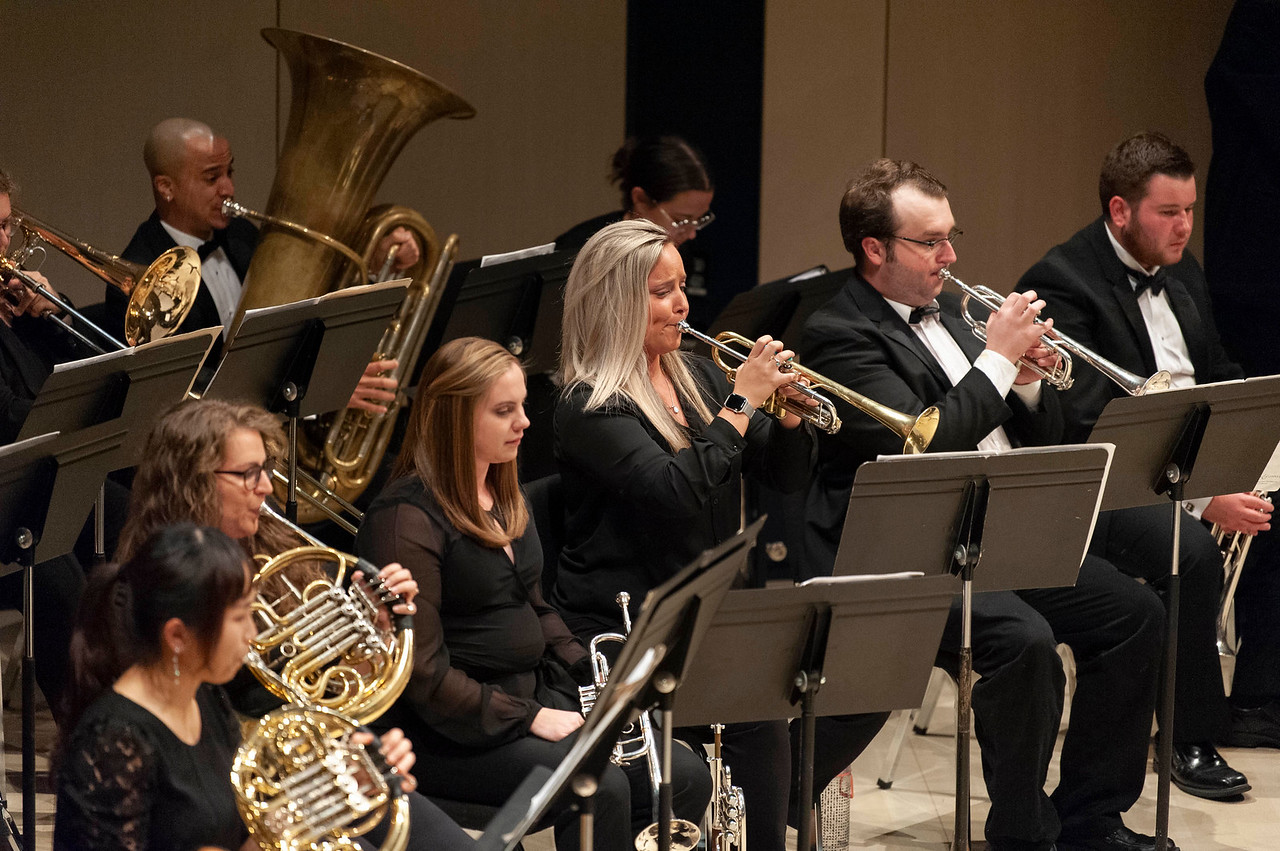
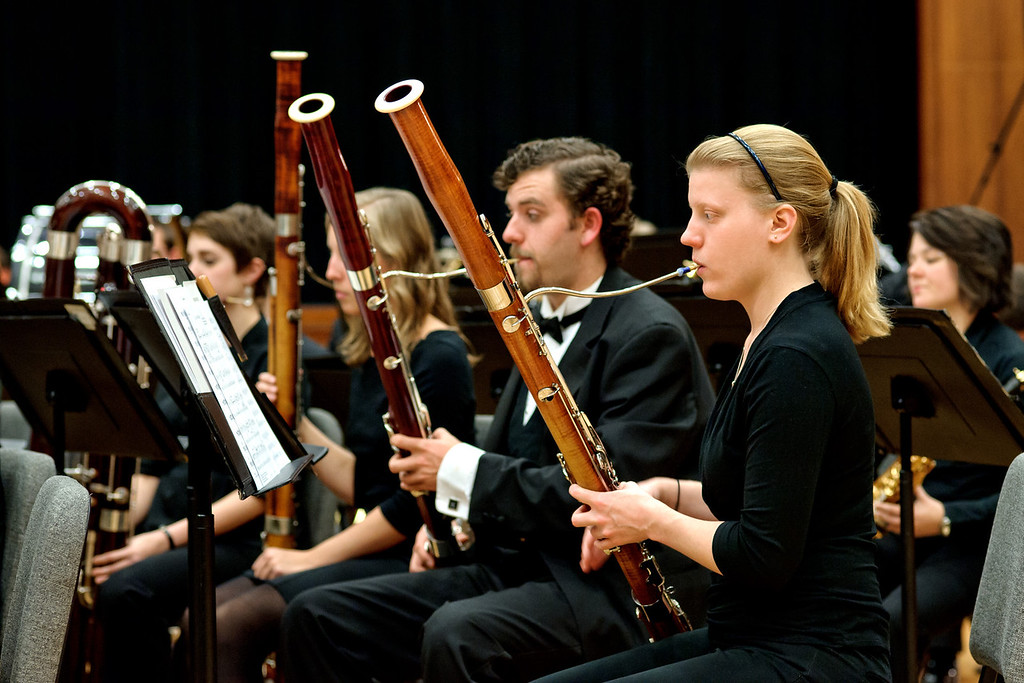

-
Brass, woodwind, and percussion players: These instrumentalists are often at an increased risk of exceeding their maximum noise dosage. Many exceed their maximum dosage during a single rehearsal – from 104-296% (Walter, 2009).
-
Brass players: Brass instrumentalists are the most likely instrumentalists to attribute work noise as being a main factor to their hearing loss (Greasley et al., 2020).
-
Percussionists: Percussionists may be at an increased risk, particularly drummers and Drum and Bugle Corps members.
-
One study showed that percussionists in Drum and Bugle Corps experienced 898-9,455% their daily noise limit in one 12-hour rehearsal day. Snare drummers received the highest dose percentage (Presley, 2007).
-
In another study, 83% of percussionists attributed work as the cause of their hearing loss (Greasley et al., 2020).
-
-
Bands: Bands are more likely to experience higher noise dosages and volume than orchestras (Smith et al., 2019).
-
Most common types of musicians to report hearing loss (Greasley et al., 2020):
-
Band member
-
Orchestra member
-
Music teacher
-
Gig/freelance instrumentalist
-
Singers
-
-
Most common instrumentalists to report hearing loss (Greasley et al., 2020):
-
Guitarists
-
Brass players
-
Percussionists
-
Woodwind players
-
Pianists
-
-
Percentage of musicians overexposed to sound in a 2-day study by instrument family (Smith et al., 2019):
| Woodwinds | 42-86% |
| Brass | 56-89% |
| Strings | 0-10% |
| Percussion | 50% |
| Voice | 17-50% |
| Piano | 33% |
-
Primary instruments to exceed recommended noise limit (Smith et al., 2019):
| Practice | Rehearsal |
|---|---|
| Brass | Brass |
| Woodwind | Woodwind |
| Piano | Percussion |
What are some additional risk factors?
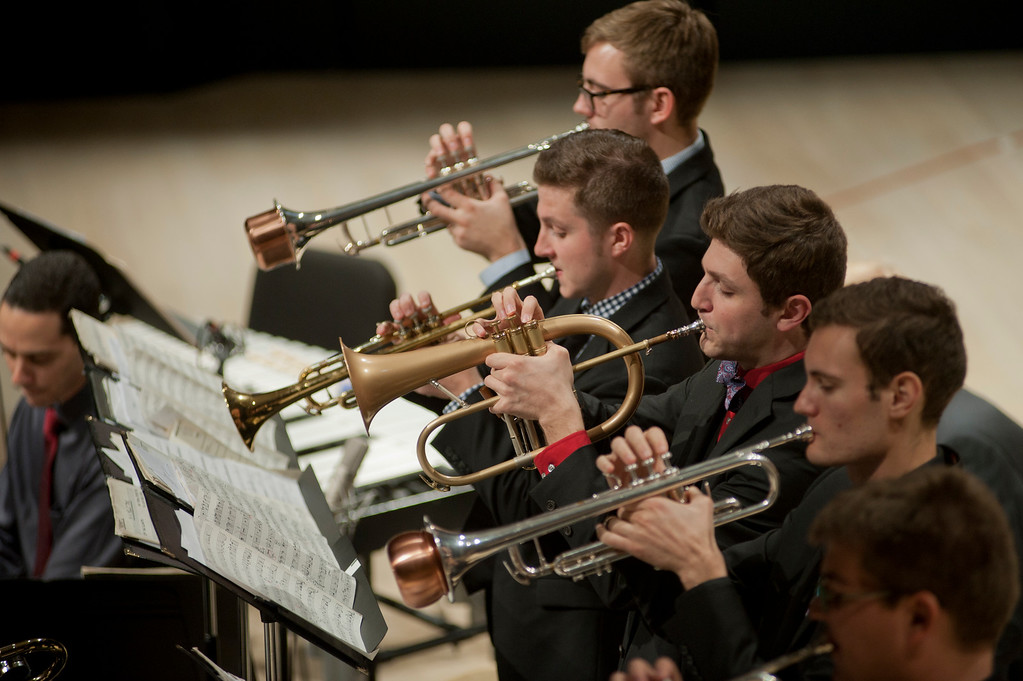
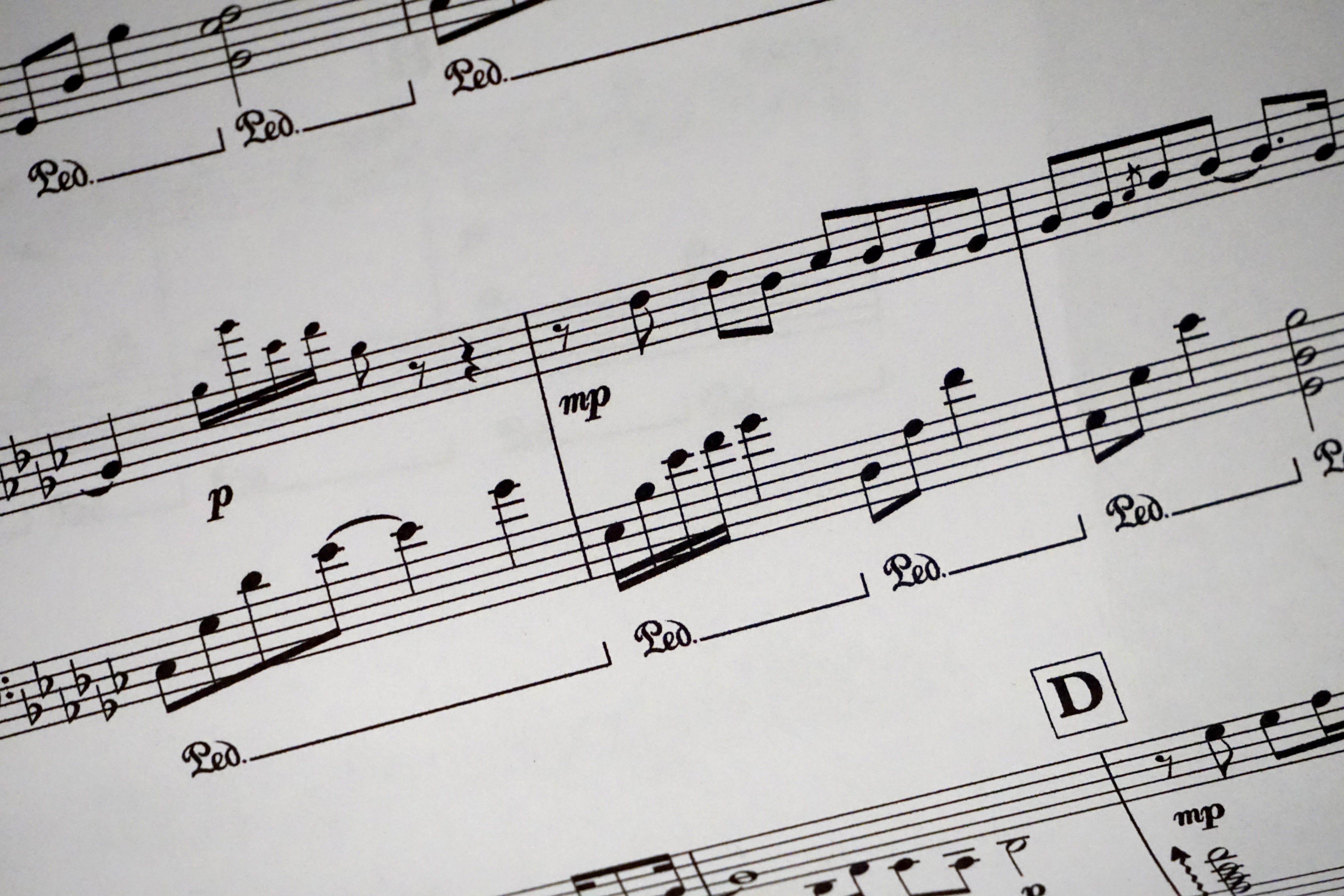
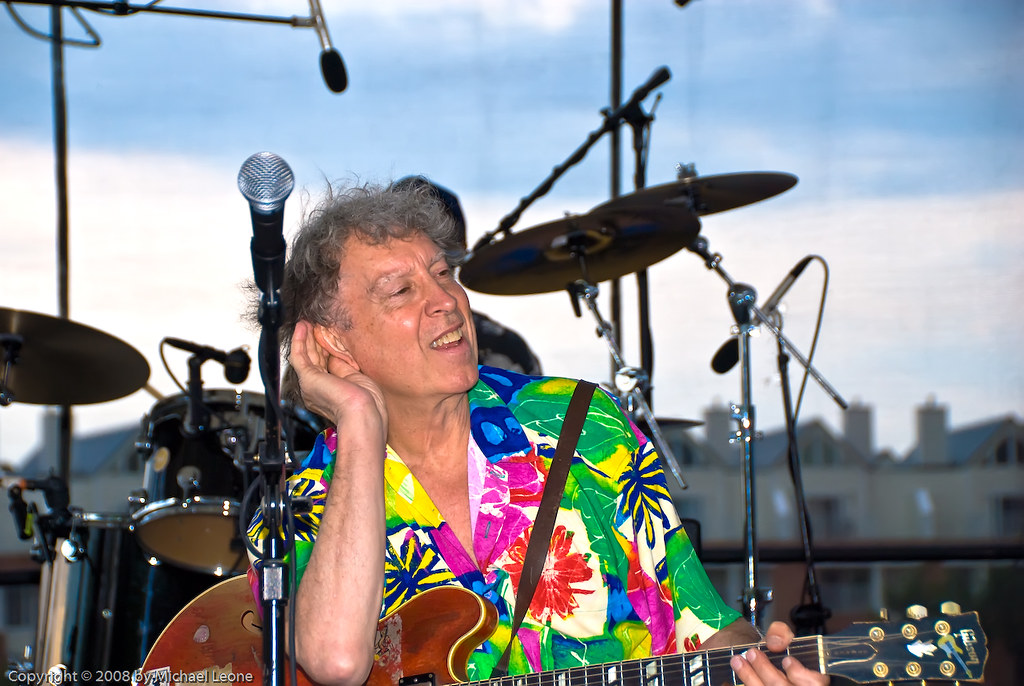
-
Music that has a lot of higher frequencies/higher notes
-
Music played at a higher decibel or volume level (typically mezzo forte and higher)
-
High levels of reverberation in the room
-
One violinist experienced a range of 3.6-25.8% of their daily noise exposure in 20 minutes depending on the setting (a sound-proof room with no reverb, compared to a reverberation hall) (Smith et al., 2019).
-
-
Riskier seating placement in the ensemble (such as in front of the brass or percussion)
-
Musicians who sit in front of louder instruments (such as in front of the drummer or trumpeter) may experience higher volume levels as a result of their neighbors.
-
A saxophonist in front of a trumpet player experienced three and a half times the NIOSH* recommended daily noise exposure in just 2 hours (Smith et al., 2019).
-
-
Musicians closer to the back of the room, who play louder instruments, receive higher noise dosages, which creates “hotspots” of high noise dosage areas due to sitting by similar instruments (Smith et al., 2019).
-
-
Genetic makeup: some people are at greater risk for noise-induced hearing loss
-
High daily length of exposure (many hours of rehearsals, practice, performances)
-
Many years of exposure
-
Extended periods of high stress levels
-
Distaste for a particular musical piece
-
Listening to loud music or sounds on personal listening devices, concerts, bars, etc.
-
Temporary Threshold Shifts, or temporary hearing loss, can occur after listening to loud noise or music continuously.
-
After leaving the loud environment (bar, club, concert), you may experience reduced hearing abilities (e.g., fuzzy or muted sounds). This may last up to 18 hours before returning to normal.
-
Repeated Temporary Threshold Shifts may result in permanent hearing loss.
-
Click here for more information about temporary threshold shifts.
-
-
-
5 hearing disorders that result from music-induced hearing loss (Kahari et al., 2003):
-
Permanent hearing loss
-
Distortion of pitch and sound quality
-
Tinnitus
-
Perception of sound in the absence of it (such as hearing whistles, roaring, or buzzing within one's ear)
-
-
Hyperacusis
-
Decreased sound tolerance, increase of physical discomfort from sound
-
Can lead to phonophobia, the fear of sound
-
-
Diplacusis
-
Inability to match pitch, or one note being heard as two different pitches
-
-
For more information on music-induced hearing loss see here.
-
-
Limited help-seeking behaviors to address or prevent hearing problems (Greasley et al., 2020):
-
Only about half of the musicians who believe they have hearing loss will go on to seek help.
-
Many musicians are likely to seek help only if they have already experienced serious hearing problems.
-
While musicians are known to be at risk of hearing loss, only 32.5% have had a hearing test.
-
The majority of individuals who had a hearing test did so because it was offered by employers, or because they experienced symptoms of tinnitus or hearing loss.
-
Older musicians were more likely to seek help than younger musicians.
-
Singers, pianists, and string players are the most likely musicians to seek help regarding hearing loss. Only 25% of brass players seek help.
-
-
-
Lack of Self-efficacy:
-
What can musicians do to protect their hearing?
Do a self-check on your attitude toward hearing protection. Be open towards changing your behaviors and doing more to preserve your hearing (Greasley et al., 2020).
-
The majority of musicians think that hearing protection should be worn, but only if the music appears loud. Have YOU considered using hearing protection?
-
One of the biggest challenges for musicians is knowing that they ought to use hearing protection, but needing to hear themselves and their neighbors well. But there are steps that CAN be taken.
-
Use earplugs as often as possible in loud environments such as concerts, rehearsals, movies, sporting events, or around loud machinery.
-
Learn about different types of earplugs, and find out what is best for you.
-
Make an appointment with an audiologist if you need more specialized hearing protection.
-
-
Three common kinds of earplugs for musicians include:
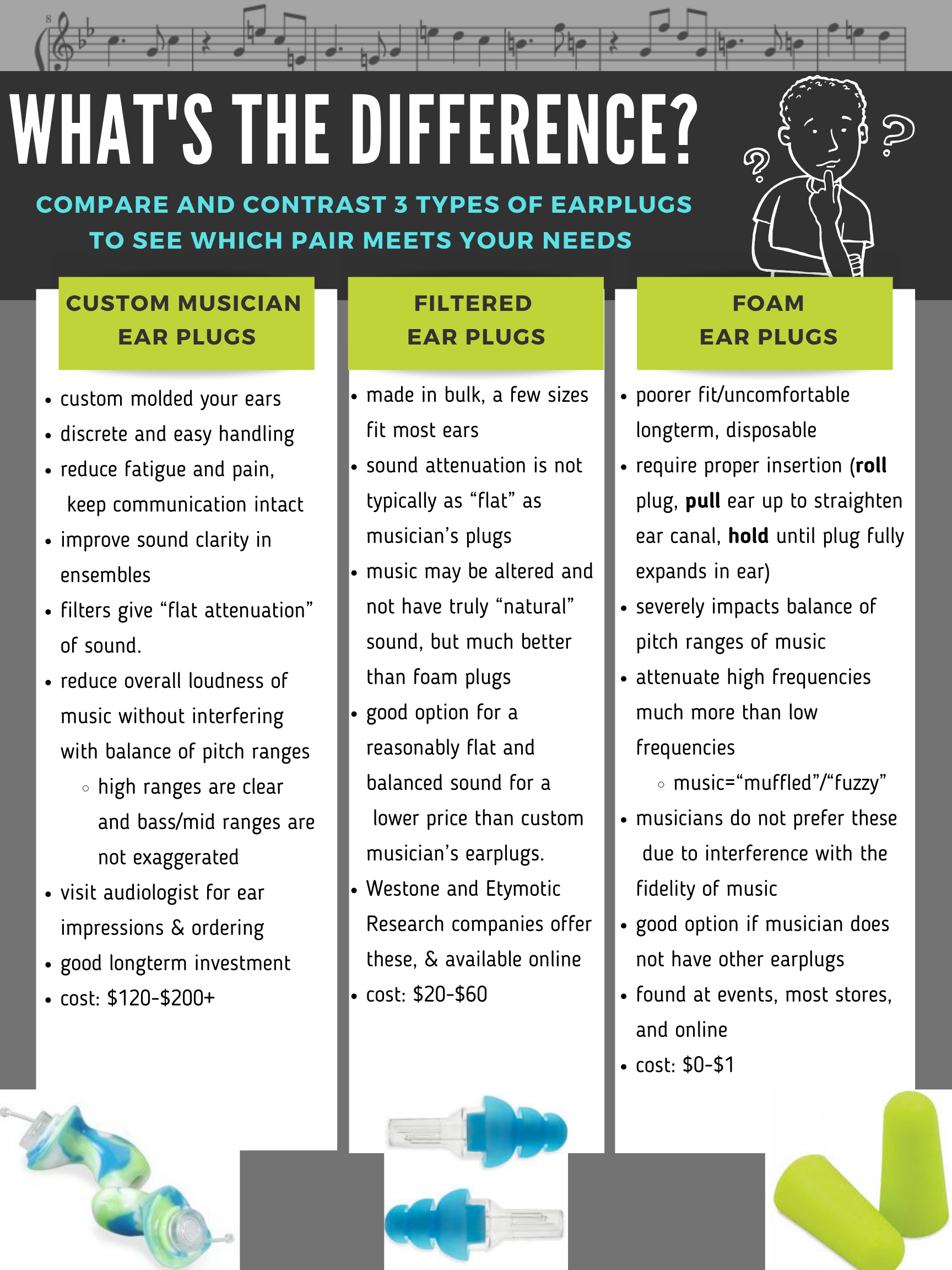
-
Custom musicians' earplugs: These cost more ($120 - $200+) but are custom fit for your ears. These are generally regarded as the best and most comfortable listening experience for musicians. They are also very durable. One pair can save your hearing for many years!
- Filtered Ear Plugs: Universal fit musicians' earplugs cost between $20 - $60, more than standard plugs from the drug store, but music sounds much better. These are sometimes called musicians' earplugs, filtered earplugs, ER-20 high-fidelity, or musicians' hearing protection. These lower all frequencies a small amount and equally. Thus, speech and music are clear, but the loud sounds are less likely to cause damage.
-
- Foam earplugs: These can protect your ears and are very cost effective. However, they will negatively impact the sound quality of music. Their best use is when you want to cut out as much sound as possible, for example when you are mowing the lawn or using power tools or heavy equipment. Sound cancellation headphones may be a good option for these situations as well.
-
To see how to correctly insert foam earplugs click on this link.
-
Have your hearing protection checked by an audiologist: Audiologists can check the effectiveness and fit of the earplugs, and test them at your typical volume level for music listening. This can help determine if your earplugs are truly protecting your hearing.
-
The main motivations for wearing hearing protection include the following (in order from highest occurrence):
-
Loud music (listening or playing)
-
Tinnitus
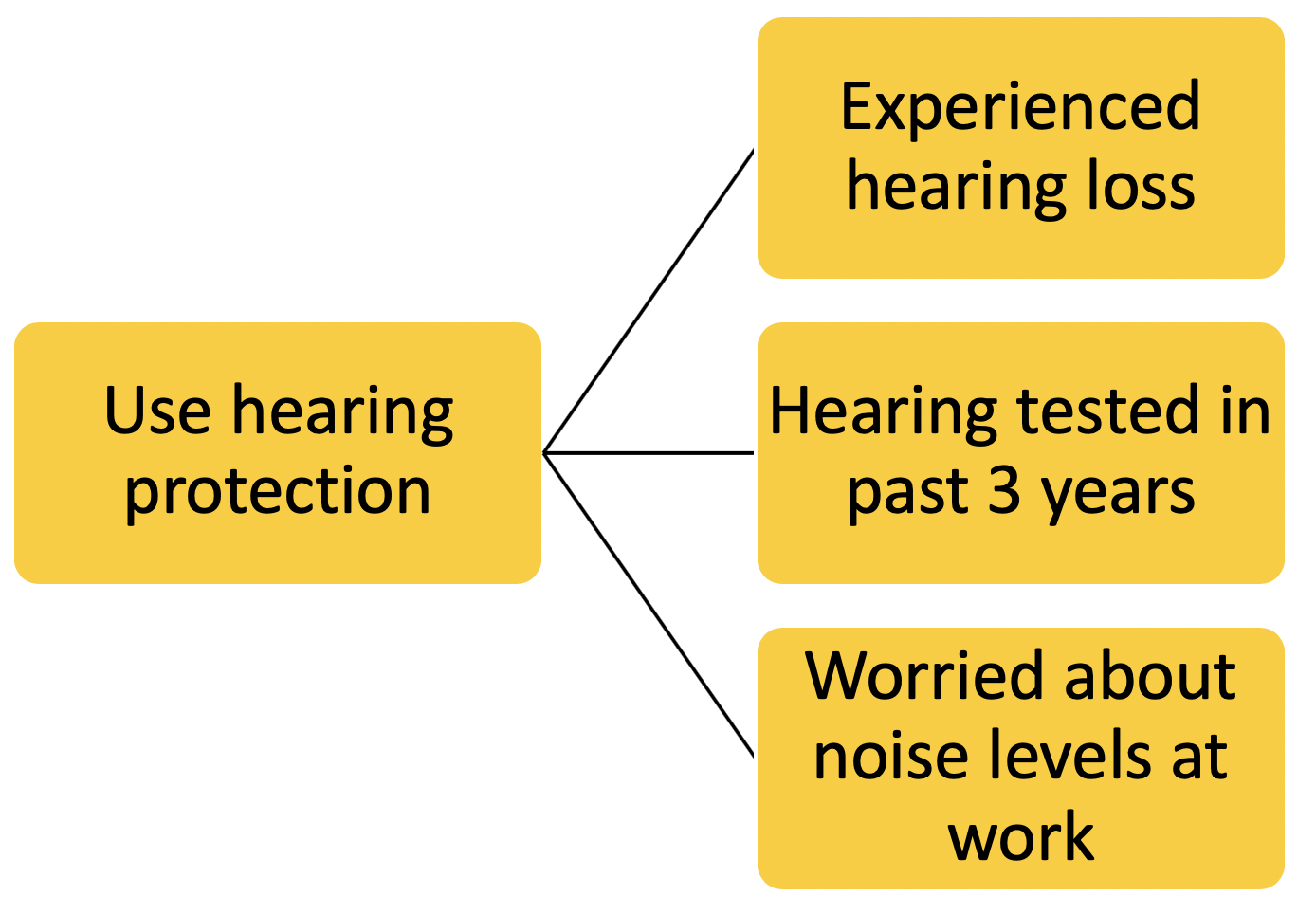
Brass, percussion, guitar, and piccolo as their main instrument
-
Advice or awareness from job/university
-
Pain/hyperacusis
-
Fear, worry, concern over hearing loss
-
To prevent further damage
-
Bad acoustics in the pit, location in an ensemble
-
Work/university provided protection
-
-
In-ear monitors for musicians are NOT hearing protection. Some studies have shown that the preferred setting by musicians for in-ear monitors was only -0.6 dB different than the floor monitors. However, the musicians approved of the reduced volume levels up to -6 dB, so in-ear monitors may be effective ONLY if volume levels are carefully watched and reduced.
-
Set up an optimal safe hearing environment
-
Speakers and amplifiers should be elevated above band members’ ears
-
Higher brass instruments (i.e. trumpets) should play on risers, or above the heads of the musicians in front of them. Note in the photo below, risers alone are not sufficient. Only one trumpet player is playing above the trombonists' heads. Remember to play above the heads of those in front of you.
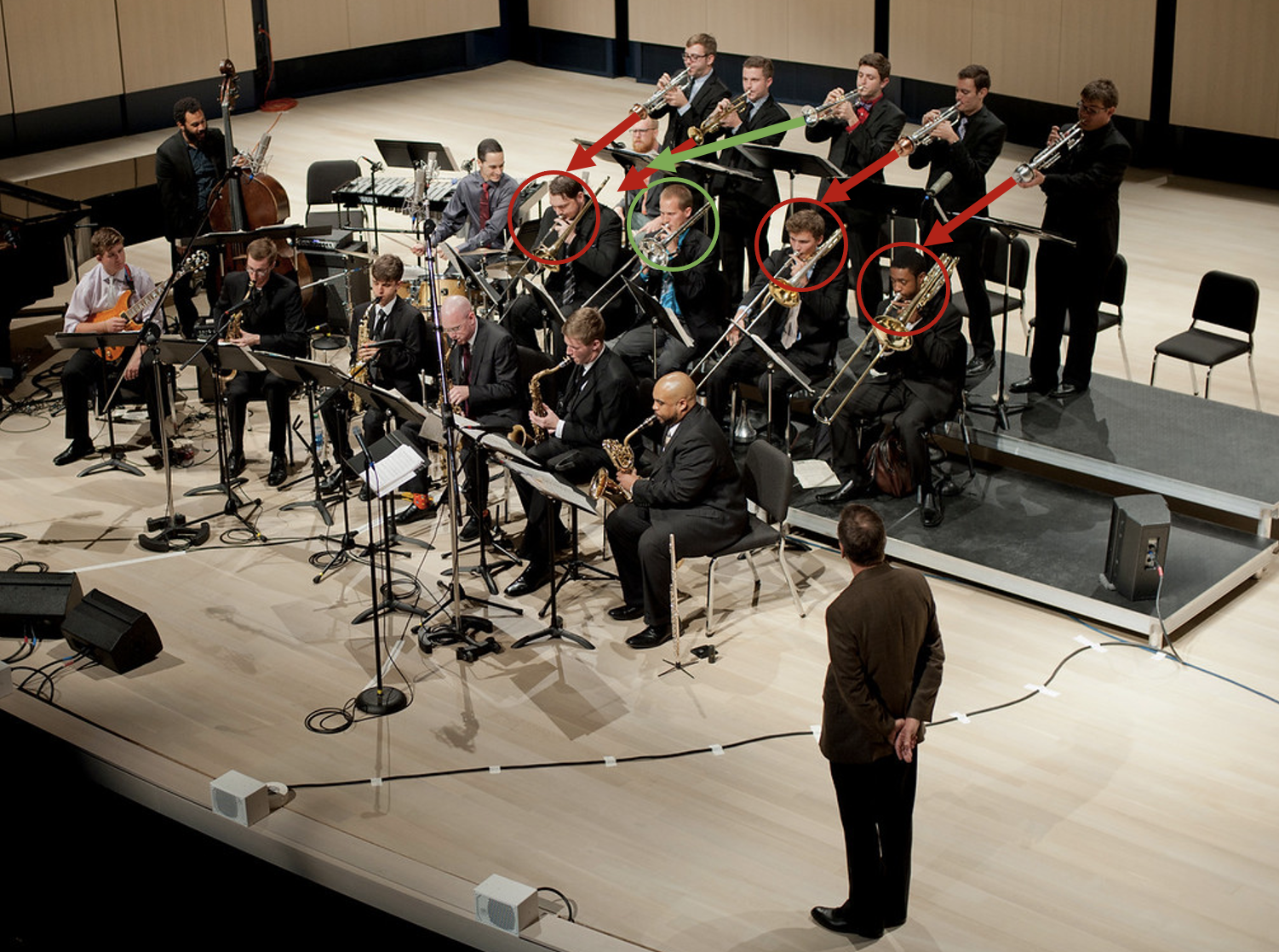
-
Musicians should be set back from the edge of the stage to allow high-frequency instruments to reflect off the front of the stage.
-
Sound baffles in the room can absorb sound and may help with hearing preservation for the instruments in front of the louder ones
-
Don't put off healthy hearing habits!
You are never too young to protect your hearing!
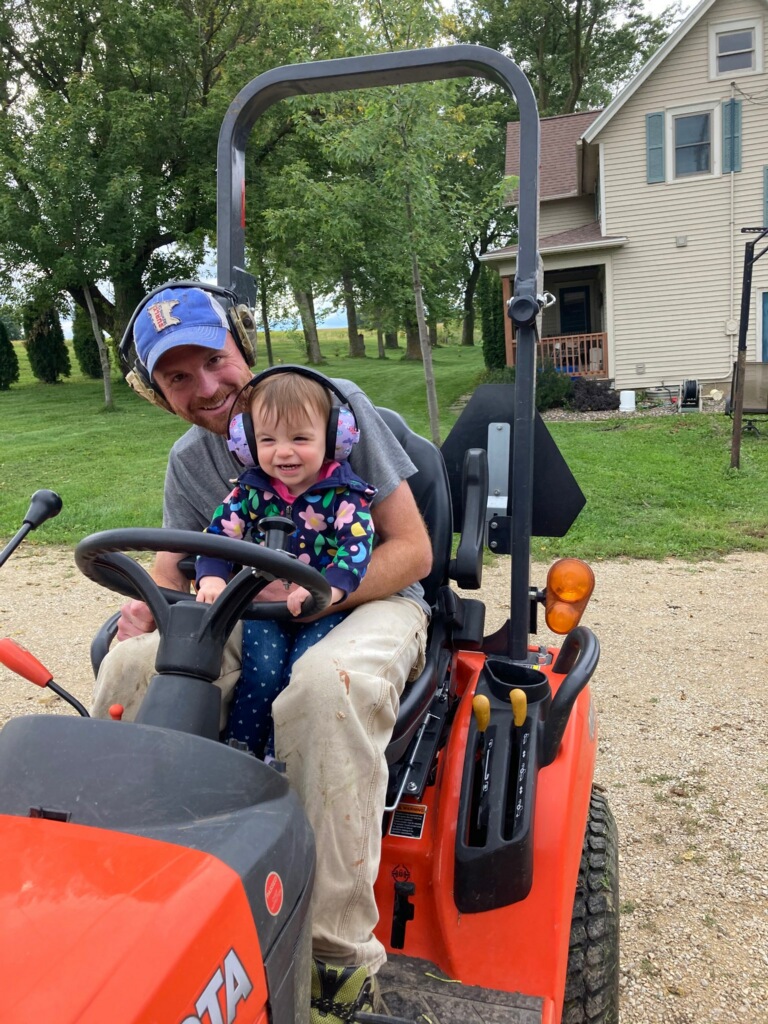
*NIOSH = National Institute for Occupational Safety
References
Behar, A., MacDonald, E., Lee, J., Cui, J., Kunov, H., & Wong, W. (2004). Noise exposure of music teachers. Journal of Occupational and Environmental Hygiene, 4, 243‐247.
Chasin, M. (2014). Hear the Music: hearing loss prevention for musicians. Toronto, Ontario: Musicians Clinics of Canada.
Fligor, B. J., & Cox, C. L. (2004). Output level of commercially available portable compact disc players and the potential risk to hearing. Ear and Hearing, 25, 513–527. doi:10.1097/00003446-200412000-00001
Gopal, K., Chesky, K., Beschoner, E., Nelson, P., & Stewart, B. (2013). Auditory risk assessment of college music students in jazz band-based instructional activity. Noise and Health, 15(65), 246-252.
Greasley, A.E., Fulford, R.J., Pickard, M., & Hamilton, N. (2020). Help Musicians UK hearing survey: Musicians’ hearing and hearing protection. Psychology of Music, 48(4), 529-546.
Hagerman, B. (2013). Musicians' ability to judge the risk of acquiring noise induced hearing loss. Noise & Health, 15(64), 199-203. doi:http://dx.doi.org.proxy.lib.uiowa.edu/10.4103/1463-1741.112376
Hodges, D. (2009). Brains and Music, Whales and Apes, Hearing and Learning . . . and More. Update: Applications of Research in Music Education, 27(2), 62-75.
Hoover, A., & Krishnamurti, S. (2010). Survey of college students’ MP3 listening: Habits, safety issues, attitudes, and education. American Journal of Audiology, 19(1), 73–83. doi:10.1044/1059-0889(2010/08-0036)
Kahari, K.R., Zachau, G., Eklof, M., et al. (2003). Assessment of hearing and hearing disorders in rock/jazz musicians. International Journal of Audiology, 42, 279-288.
Levey, S., Levey, T., & Fligor, B. J. (2011). Noise exposure estimates of urban MP3 player users. Journal of Speech, Language, and Hearing Research, 54(1), 263–277. doi:10.1044/1092-4388(2010/09-0283)
Pawlaczyk-Luszczynska, M., Zamojska-Daniszewska, M., Dudarewicz, A., & Zaborowski, K. (2017). Exposure to excessive sounds and hearing status in academic classical music students. International Journal of Occupational Medicine and Environmental Health, 30(1), 55-75.
Phillips, S., & Mace, S. (2008). Sound-level measurements in music practice rooms. Music Performance Research, 2, 36–47.
Phillips, S., Shoemaker, J., Mace, S., & Hodges, D. (2008). Environmental factors in susceptibility to noise-induced hearing loss in student musicians. Medical Problems of Performing Artists, 23, 20–28.
Presley, D. (2007). An analysis of sound-exposures of drum and bugle corps percussionists. Percussion Notes, August, 70–75.
Smith, K., Neilsen, T., & Grimshaw, J. (2019). University student musician noise-dosage study measuring both ensemble and full-day noise exposure. The Journal of the Acoustical Society of America, 145(6), EL494.
Walter, J. S. (2009). Sound exposure levels experienced by university wind band members. Medical Problems of Performing Artists, 24(2), 63-70. Retrieved from http://proxy.lib.uiowa.edu/login?url=https://search-proquest-com.proxy.l...
Walter, J. S., Mace, S. T., & Phillips, S. L. (2008). Preventing Hearing Loss. Published Proceedings from the National Association of Schools of Music 2006 Annual Meeting, Chicago, Illinois.
Click here to review references used in preparation of this website.
1. All images on this website are used under Creative Commons or other licenses or have been created by the website developers.
2. Click here to access the sources of images on this page.
